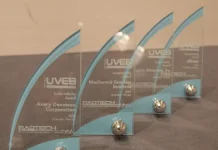New Materials, Technology, Designs Awarded at RadTech 2018
UV+EB Technology
With a focus on high tech manufacturing, efficiency, energy savings and sustainability, the RadTech 2018 Conference and Exhibition in May recognized several contributions to the development of emerging and novel ultraviolet and electron beam technologies.
Emerging Technology Award Winners
- MicroTau Pty Ltd, New South Wales, Australia, was presented with one of the events Emerging Technology Awards for their low cost, printed shark-skin surface, demonstrated to reduce drag and improve efficiency for airplanes, cars, other vehicles and wind turbines; and provide biocide-free antifouling materials for marine vessels; antibacterial surfaces in hospitals and aircraft tray tables; and self-cleaning paints and microfluidic devices.
- Lumii Inc. for enabling captivating hologram-like imagery using standard presses, media and inks for security and brand protection. This is achieved by applying sophisticated tera-scale computation to model billions to trillions of light rays as they interact with high-resolution printed material. The Lumii process disrupts many of the conventions associated with traditional security devices.
- DENTSPLY Sirona has patented highly effective antimicrobial/antibacterial resins. Such resins can be readily formulated in a variety of compositions, such as composites, adhesives, sealants and coatings to provide high performance nonleaching active surfaces to effectively kill a wide range of bacterium. It also could be used to potentially dramatically ease biofilm removal.
- LiTeProducts LLC has developed adaptive lighting, mixing multi-wavelength, multi-tasked UV LEDs with visible light LEDs for novel germicidal and 3D curing applications. Potential applications for these unique solutions include leafy green vegetable sanitation, which includes a UV cure seal of packaging to lock in freshness benefits; and sanitation of water, air and the surface of objects with an added UV-printed verification that communicates that sanitation has indeed occurred.
- A special Collegiate Emerging Technology Award went to a team from the Coatings Research Institute at Eastern Michigan University for the development of ’Green UV-LED Curable Nail Gel Polishes from Bio-Renewable Materials. In this innovation, novel polymers are synthesized from bio-renewable materials, such as plant oils (soybean oil, corn oil, canola oil), itaconic acid, gum rosin and bio-based succinic acid.
The event also featured lively cutting-edge topical panel discussions and a technical conference with more than 100 presentations. The best paper award for the event went to Natasha Banke, INX International Ink Company, for Residual building block chemicals in raw materials and finished printing inks – A risk assessment approach to manufacturing and detection limits. Best student paper went to Forough Zareanshahraki, from the Coatings Research Institute at Eastern Michigan University, and her advisor, Prof. Vijay Mannari, for ’Green UV-LED Gel Nail Polishes from Bio-Based Materials.
In a partnership with the Technical Association of the Graphic Arts (TAGA), the event also held a student poster competition, asking students to develop a well-designed, impactful poster touting UV/EB technology. First place went to Olivia Blandford, from High Point University; and second place to Ryan Hutson, from California Polytechnic State University. RadTech will feature these posters in UV+EB Technology magazine and website (www.uvebtech.com).
Finally, RadTech formally introduced its class of 2018 for RadLaunch Accelerator, including:
- Trio Labs for Rapid UV 3D printing to create metal and ceramic parts with the same characteristics achieved through standard powder injection molding (PIM) processes.
- Reboot Medical, Inc. for PhotoCast Casting Tape, light-cured composite tape that hardens on-demand, producing a rigid splint or cast.
- Team from The Hebrew University of Jerusalem for Nanocrystal photocatalysts, which fill an unmet need for efficient water-soluble photoinitiators for coatings and 2D/3D printing.
- moi composites for a new, patented process that merges the performances of thermosetting composite materials with the potentialities of additive manufacturing, opening the world of advance composites to features unimaginable today.
- The Foam Printing Project for lightweight parts from resin that is foamed using a patent-pending process and solidified using a UV DLP 3D printer. The parts have up to 75% gas fractions, are lighter weight and less expensive to produce.
- Dynamic Matter LLC for UV-curable thermosetting polymer that can be remolded or repurposed after polymerization for use in optical applications and composites to reduce shrinkage and environmental stresses.
- Team from the University of Iowa for transferrable shadow cure (TSC), which decouples initiation and propagation mechanisms in cationic photopolymerization to address light penetration problems, thus providing full cure regardless of geometry, pigment and filler content, and sensitivity of material to light and heat.





